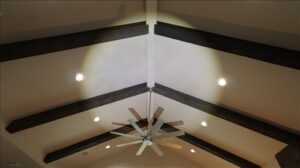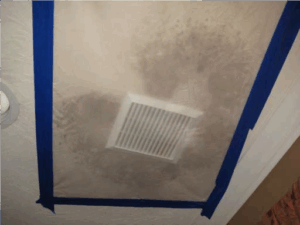While water intrusion into building interiors is a well known cause of moisture damage, problems related to the effects of relative humidity are less familiar to many. Relative humidity is the ratio of the amount of moisture contained in the air compared to the maximum amount of moisture that the air can hold at a given temperature. For a given volume of air, an inverse relationship exists between the space temperature and the relative humidity; a decrease in the space temperature results in a corresponding increase in the relative humidity. For example, if the set-point temperature for the air-conditioned space is too low, the relative humidity can increase to a level that creates moisture issues.
In a cooling climate (i.e., a warm climate where interior spaces are commonly cooled for comfort), improper sizing of the air-conditioning equipment can result in elevated indoor relative humidity. If the air-conditioning equipment is significantly oversized, its dehumidification capacity is reduced because the refrigerant circuit does not operate continuously; it cycles on and off to maintain the space temperature setpoint. When the compressor is off, the moisture removal process stops, and the supply air fan can return a portion of the condensate that has accumulated on the cooling coil fins back into the conditioned space.
Seasonal changes can also result in elevated indoor relative humidity. For example, during the Spring and Fall (entering and leaving the cooling season) air-conditioning equipment will operate intermittently, reducing its dehumidification capacity, similar to an oversized system. As a result, the indoor relative humidity in a cooling climate will often peak during the spring and fall.
Indoor spaces with high relative humidity can be susceptible to moisture-related problems from mold, mildew, and localized occurrences of condensation on surfaces. Such issues will often manifest in areas where there is less airflow, such as closed rooms or ceilings vaulted above the elevation of the supply air registers and return air grills (Figure 1).

Figure 1. A vaulted ceiling that extended higher than the supply and return air exhibited surface staining and elevated moisture. This staining was only observed at the vaulted area, not at the remainder of the interior gypsum board finishes.
Activities such as showering, bathing, cooking, dishwashing, clothes washing/drying, and floor cleaning can also cause localized areas of increased indoor relative humidity. As a result, moisture-related issues are often observed in areas such as bathroom ceilings (Figure 2).

Figure 2. Staining and suspected fungal growth on a bathroom ceiling.
Condensation forms when the temperature of a surface is lower than the dew point of the moist air in the vicinity. At interiors with high relative humidity, condensation is often observed at items such as metal supply air registers and recessed lights fixtures (Figures 3 and 4).

Figure 3. Moisture distress at a ceiling due to condensation and high relative humidity at the supply air register and can lights.

Figure 4. Condensation and suspected fungal growth at a supply air register
Nelson’s team of professionals is well versed at evaluating buildings for interior moisture issues, including problems related to the sizing or performance of the air-conditioning equipment and other causes of elevated relative humidity.

